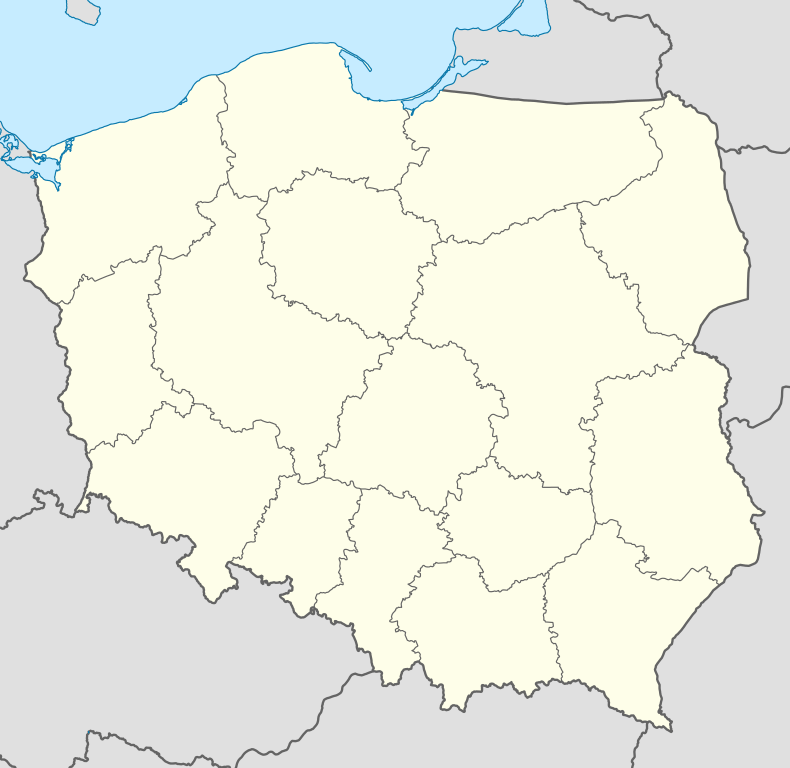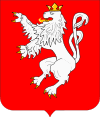Gorzanów
| Gorzanów | |
|---|---|
| Village | |
 Gorzanów | |
| Coordinates: 50°21′07″N 16°37′56″E / 50.35194°N 16.63222°ECoordinates: 50°21′07″N 16°37′56″E / 50.35194°N 16.63222°E | |
| Country |
|
| Voivodeship | Lower Silesian |
| County | Kłodzko |
| Gmina | Bystrzyca Kłodzka |
| Population | 921 |
Gorzanów [ɡɔˈʐanuf] is a village in the administrative district of Gmina Bystrzyca Kłodzka, within Kłodzko County, Lower Silesian Voivodeship, in south-western Poland.[1] Prior to 1945 it was in Germany.
It lies approximately 6 kilometres (4 mi) north of Bystrzyca Kłodzka, 10 kilometres (6 mi) south of Kłodzko, and 91 kilometres (57 mi) south of the regional capital Wrocław.
The village has a population of 921.
Name and history
The earliest name of the locality seems to have been the German appellation Arnoldsdorf (or Arnsdorf), derived from the personal name Arnold (+dorf). The later German name of Grafenort derives from the noble title Graf (+ort, "locality"). In the seventeenth century the owner of the village was Johann Gundacker Graf von Heberstein. The name "Gorzanów" was introduced officially only after 1945.[2] The name "Gorzanów" appears in the standard gazetteer of Polish place-names, the Słownik geograficzny Królestwa Polskiego (vol. 7, p. 239, col. 1), only with reference to a Polish village in the Podolia, a different geographical region. The village discussed in the present article is listed under the name Grafenort (Słownik geograficzny, vol. 2, p. 791, col. 1), without a corresponding Polish toponymic.
The Słownik geograficzny Królestwa Polskiego states that, historically, theatrical performances were staged at "the beautiful castle of the Hebersteins" three times a week for eight months of the year, and that the place was known for its "steam baths". The village had a Catholic church, and a chapel dedicated to St. Anthony surmounting a hill of the same name, which rises to the height of 1,053 feet above sea level. The location is described as "utterly exquisite" (prześliczne położenie).[3]
During the Second World War the Nazis established a concentration camp on the premises of the palace,[4] a satellite camp of Gross-Rosen concentration camp.
A present-day guidebook describes the "palace of Gorzanów" as being in a complete state of dilapidation, unfit to accommodate sightseers.[5]
Bibliography
- Waldemar Brygier, Tomasz Dudziak, et al., Ziemia Kłodzka: przewodnik dla prawdziwego turysty, Piastów, Oficyna Wydawnicza Rewasz, 2010, pages 328–330. ISBN 9788389188953.
References
- ↑ "Central Statistical Office (GUS) - TERYT (National Register of Territorial Land Apportionment Journal)" (in Polish). 2008-06-01.
- ↑ Nazwy miejscowe Polski: historia, pochodzenie, zmiany, ed. K. Rymut, vol. 3 (E–I, ed. Urszula Bijak, et al.), Cracow, Wydawnictwo IJP PAN (Institute of the Polish Language of the Polish Academy of Sciences), 1999, p. 251. ISBN 838557929X, ISBN 8385579453.
- ↑ Słownik geograficzny Królestwa Polskiego, vol. 2, p. 791, col. 1.
- ↑ Waldemar Brygier, Tomasz Dudziak, et al., Ziemia Kłodzka: przewodnik dla prawdziwego turysty, Piastów, Oficyna Wydawnicza Rewasz, 2010, p. 329. ISBN 9788389188953.
- ↑ Waldemar Brygier, Tomasz Dudziak, et al., Ziemia Kłodzka: przewodnik dla prawdziwego turysty, Piastów, Oficyna Wydawnicza Rewasz, 2010, p. 219. ISBN 9788389188953.
